The Canon EOS 350D, also known as the Digital Rebel XT, is an 8.0-megapixel entry-level DSLR. Released in 2005, it succeeded the EOS 300D, offering improved features like a 3 frames-per-second shooting rate and enhanced autofocus. Designed for photography enthusiasts and beginners, it combines ease of use with advanced capabilities, making it a versatile tool for capturing high-quality images. Available in various regions as the EOS Kiss Digital N, it remains popular for its balance of performance and affordability.
1.1 Key Features of the Canon EOS 350D
The Canon EOS 350D offers an 8.0-megapixel CMOS sensor, delivering sharp and detailed images. It features a 3 frames-per-second continuous shooting mode, ideal for capturing dynamic moments. The camera is equipped with a DIGIC II image processor, enhancing speed and image quality. Its 7-point autofocus system ensures precise subject tracking, while the 2.5 cm LCD screen provides clear image preview and menu navigation. The EOS 350D supports EF-S and EF lenses, offering versatility for various shooting scenarios. Additional features include manual controls, customizable settings, and compatibility with external flash units, making it a versatile tool for both beginners and advanced photographers.
1.2 Target Audience and Usage Scenarios
The Canon EOS 350D is designed for photography enthusiasts and beginners, offering a user-friendly interface and advanced manual controls. Its portability and ergonomic design make it ideal for everyday photography, travel, and portraits. The camera is also suitable for action and sports photography due to its 3 frames-per-second continuous shooting mode. Hobbyists and professionals seeking a compact yet powerful DSLR will appreciate its versatility. Additionally, the EOS 350D is a great choice for educational purposes, allowing users to explore various shooting modes and techniques. Its compatibility with a wide range of lenses and accessories further enhances its appeal for diverse photography scenarios.

Product Overview
The Canon EOS 350D is a high-performance, 8.0-megapixel DSLR camera designed for enthusiasts and professionals. It features a compact design, intuitive controls, and advanced shooting modes, delivering excellent image quality and versatility for various photography needs.
2.1 Design and Build Quality
The Canon EOS 350D features a sturdy and ergonomic design, with a compact body that fits comfortably in the hand. The camera is constructed from high-quality materials, including a durable plastic exterior, ensuring both reliability and portability. The lightweight design makes it easy to carry, while the intuitive layout of controls provides quick access to essential functions. The 2.5-inch LCD screen offers a clear view of images and settings, enhancing the overall user experience. Despite its affordable price point, the EOS 350D maintains a solid build quality, making it a reliable choice for photographers of all skill levels.
2.2 Technical Specifications
The Canon EOS 350D features an 8.0-megapixel CMOS sensor, delivering high-resolution images with excellent detail. It is powered by the DIGIC II image processor, ensuring fast operation and precise color reproduction. The camera offers an ISO range of 100-1600, expandable to 3200 for low-light conditions. It supports continuous shooting at 3 frames per second and has a shutter speed range of 1/4000 to 30 seconds. The EOS 350D records images in JPEG and RAW formats and uses CF/MD cards for storage. It is compatible with EF-S lenses, has a 7-point autofocus system, and includes a 2.5-inch LCD screen for preview and review. Battery life is approximately 400 shots per charge.

Initial Setup and Configuration
Start by inserting the battery, memory card, and adjusting basic settings like date, time, and language. Refer to the manual for detailed setup guidance.
3.1 Unboxing and First Impressions
The Canon EOS 350D comes neatly packaged with the camera body, an EF-S 18-55mm lens, battery, charger, USB cable, and user manual. Upon opening, the solid build quality and ergonomic design immediately stand out. The camera feels lightweight yet durable, with a comfortable grip. The 2.5-inch LCD screen is bright and clear, providing a good preview of images. The menu system is intuitive, making it easy to navigate for both beginners and experienced photographers. The lens mount is sturdy, and the included lens offers a versatile focal range for everyday shooting. First impressions are overwhelmingly positive, with the camera feeling ready to use right out of the box.
3.2 Charging the Battery and Initial Power-On
To begin, insert the supplied NB-2LH battery into the charger, ensuring the contacts align properly. Plug the charger into a power source and wait for the charging indicator to turn green, signaling a full charge (approximately 90 minutes). Once charged, insert the battery into the camera’s compartment, located on the bottom. Flip the power switch to the “ON” position, and the camera will perform a brief startup sequence. The LCD screen will illuminate, displaying basic settings like date, time, and shooting mode. The camera is now ready for use. Refer to the manual for setting the date and time before capturing your first images.
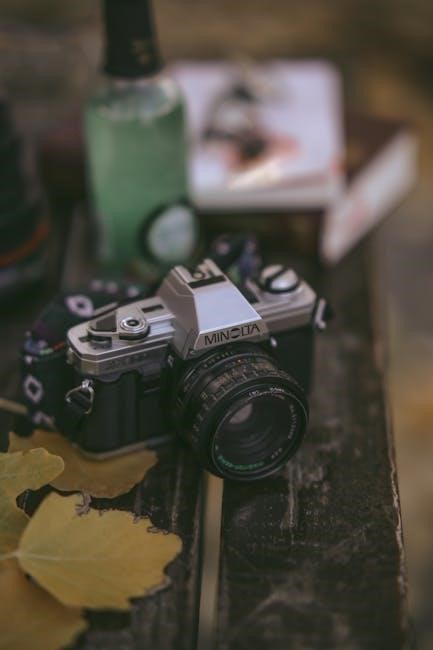
Navigation and Controls
The Canon EOS 350D features an intuitive control layout, with a mode dial, main dial, and navigation buttons for easy access to settings and menus.
4.1 Understanding the Camera Layout
The Canon EOS 350D features a well-organized design, making it easy for users to navigate. The mode dial on top allows quick access to shooting modes like Auto, Manual, and Aperture Priority. The main dial, located near the shutter button, adjusts settings like aperture and shutter speed. The LCD screen on the rear displays menu options, settings, and image previews. The navigation buttons enable easy scrolling through menus, while the multi-controller simplifies selecting autofocus points. The camera’s ergonomic grip and logical control placement ensure intuitive operation, allowing photographers to focus on composition and creativity without confusion. This layout is designed for both beginners and advanced users to find controls effortlessly.
4.2 Customizing Buttons and Controls
The Canon EOS 350D allows users to customize buttons and controls for a personalized shooting experience. The Depth of Field Preview button and the SET button can be assigned to functions like ISO, white balance, or flash compensation. This customization is accessed through the Custom Functions menu, where users can select their preferred assignments. The multi-controller and quick control dial can also be configured for easier access to frequently used settings. By tailoring button functions, photographers can streamline their workflow and enhance efficiency. This feature is particularly useful for advanced users seeking to optimize their camera for specific shooting styles or preferences, ensuring faster access to essential controls during photography sessions.
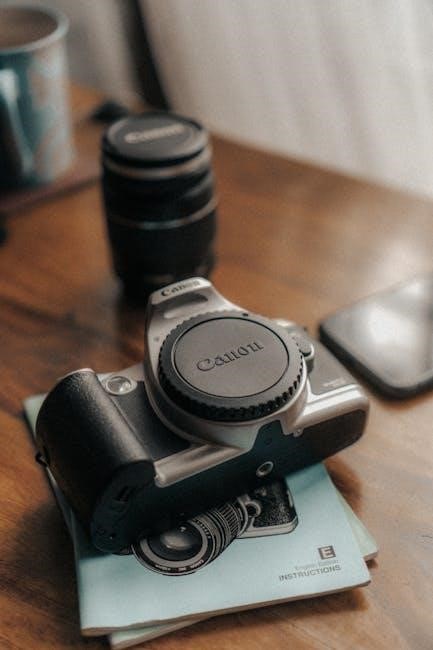
Shooting Modes
The Canon EOS 350D offers a variety of shooting modes, including Full Auto, Program AE, Shutter Priority, Aperture Priority, and Manual, catering to both beginners and advanced photographers. Scene modes like Portrait and Landscape also provide tailored settings for specific subjects, while Custom modes allow users to save personalized configurations for quick access, ensuring versatility and convenience in different shooting scenarios, making it adaptable to diverse photography needs and skill levels, from casual snapshots to professional-grade images with precise control over exposure settings and creative elements.
5.1 Auto Mode for Beginners
The Canon EOS 350D’s Auto Mode is designed for beginners, offering a hassle-free photography experience. In this mode, the camera automatically adjusts settings like aperture, shutter speed, ISO, and white balance to ensure well-exposed images. Users can simply point and shoot, focusing on composition without worrying about technical details. The camera prioritizes ease of use, making it ideal for newcomers to photography. It’s a great starting point for learning the basics before transitioning to more advanced modes. This mode is perfect for capturing everyday moments, portraits, and landscapes with minimal effort, providing a seamless introduction to the world of DSLR photography.
5.2 Manual Mode for Advanced Users
Manual Mode on the Canon EOS 350D offers full creative control, ideal for advanced users. It allows customization of aperture, shutter speed, ISO, and white balance to achieve precise results. This mode is perfect for photographers who understand exposure principles and want to fine-tune their shots. Users can experiment with artistic effects, such as motion blur or depth of field, by manually adjusting settings. The camera’s metering system provides guidance, but ultimate control lies with the user. Manual Mode is recommended for those familiar with the exposure triangle and seeking to push their photography skills to the next level for professional-quality images.
5.3 Aperture Priority and Shutter Priority Modes
Aperture Priority (Av) and Shutter Priority (Tv) modes on the Canon EOS 350D offer flexibility for photographers who want control over specific aspects of their shots. In Av mode, users set the aperture, and the camera adjusts the shutter speed to maintain proper exposure. This is ideal for controlling depth of field, such as isolating subjects or ensuring landscape sharpness. Tv mode allows setting the shutter speed, with the camera adjusting the aperture, perfect for freezing fast action or creating motion blur. Both modes provide a balance between creative control and automation, making them versatile for intermediate photographers looking to refine their techniques without manual mode complexity. These modes are essential for enhancing image quality and achieving desired artistic effects in various shooting conditions.
5.4 Custom Shooting Modes
The Canon EOS 350D offers Custom Shooting Modes, including Portrait, Landscape, Close-up, Sports, and Night Portrait, designed for specific scenarios. These modes automatically adjust settings like aperture, shutter speed, and ISO to optimize results. Portrait mode uses a large aperture for shallow depth of field, while Landscape mode employs a small aperture for sharpness across the frame. Sports mode prioritizes fast shutter speeds to freeze action, and Night Portrait balances flash with ambient light. These modes simplify photography for users of all skill levels, allowing them to achieve professional-looking results without manual adjustments. They are ideal for capturing fleeting moments and diverse subjects with ease and precision.
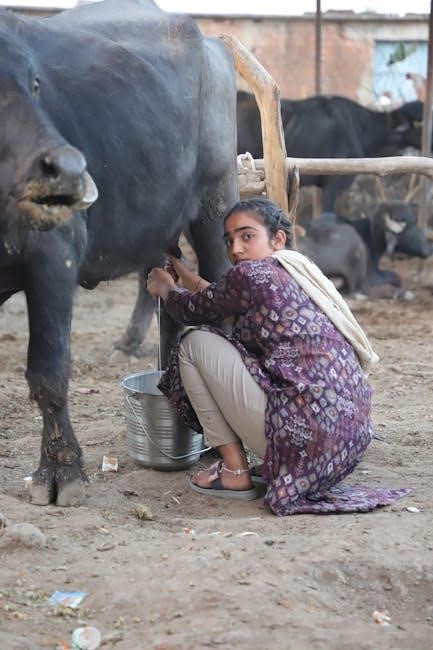
Customization and Personalization
The Canon EOS 350D allows users to tailor settings to their preferences, enabling a personalized shooting experience through custom functions, button assignments, and image processing adjustments.
6.1 Setting Up Custom Functions
The Canon EOS 350D offers customizable functions to tailor camera behavior to personal preferences. Access the Custom Functions menu via the main menu, then use the directional pad to navigate and adjust settings. Options include autofocus and metering modes, button assignments, and exposure adjustments. Each function can be modified to suit specific shooting styles or scenarios, enhancing efficiency and control. For instance, users can set the AF mode to prioritize speed or accuracy based on their needs. These adjustments are saved automatically, ensuring consistent performance across shoots; Customizing these functions allows photographers to streamline their workflow and optimize the camera for their creative vision.
6.2 Adjusting White Balance and Color Settings
Adjusting white balance and color settings on the Canon EOS 350D ensures accurate color representation in various lighting conditions. The camera offers multiple white balance options, including Auto, Daylight, Shade, Tungsten, Fluorescent, and Custom. Use the Custom White Balance feature by selecting a white object in the scene and setting it as the reference point. Additionally, users can fine-tune color settings, such as saturation and tone, to enhance image quality. These adjustments can be made via the camera’s menu system, allowing photographers to achieve their desired aesthetic. Properly setting white balance and color settings is essential for capturing images that reflect the true colors of the scene.
6.3 Configuring Autofocus and Metering Modes
Configuring autofocus and metering modes on the Canon EOS 350D enhances your shooting experience by optimizing focus accuracy and exposure. The camera offers three autofocus modes: One-Shot AF for stationary subjects, AI Servo AF for moving subjects, and AI Focus AF, which switches between the two. Metering modes include Evaluative, Center-Weighted, and Partial, allowing you to control how the camera measures light. Adjust these settings via the camera’s menu or external controls to suit your scene. Proper configuration ensures sharp focus and balanced exposure, improving overall image quality. Experimenting with these modes helps you master different shooting scenarios effectively.
6.4 Saving Custom Settings
Saving custom settings on the Canon EOS 350D streamlines your workflow by preserving personalized configurations. Access the menu, navigate to Custom Functions, and adjust settings like autofocus, metering modes, and white balance. Once configured, select “Save Custom Settings” to store your preferences. This ensures consistent results across different shoots. Saved settings can be quickly retrieved, enhancing efficiency. Regularly reviewing and updating your custom settings adapts to evolving photography needs, maintaining optimal performance. This feature is invaluable for photographers seeking precision and convenience, allowing them to focus on creativity rather than repeated adjustments.
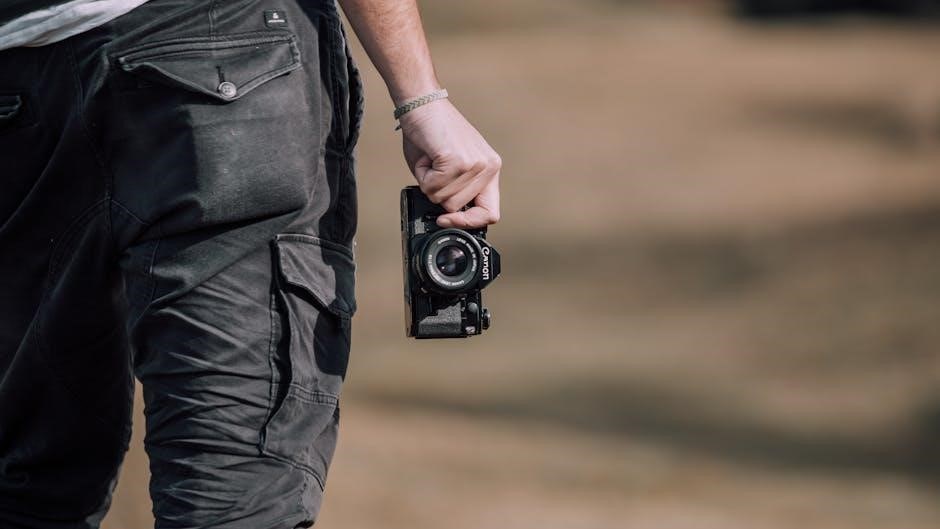
Advanced Features
The Canon EOS 350D offers advanced features like Live View for precise framing, Image Stabilization for reduced camera shake, and Continuous Shooting for capturing action seamlessly.
7.1 Using Live View for Precise Framing
Live View on the Canon EOS 350D allows users to preview shots directly on the LCD screen, enabling precise framing and composition. Activate it via the Live View button for real-time monitoring. This feature is ideal for still subjects, macro photography, or when precise focus control is needed. Use the LCD’s zoom function to check focus accuracy. For stability, mount the camera on a tripod. Live View enhances creative control, ensuring images are framed exactly as intended. However, it may drain battery life faster, so monitor usage. This tool is invaluable for achieving sharp, well-composed results, especially in challenging lighting conditions.
7.2 Enabling Image Stabilization
Image Stabilization (IS) on the Canon EOS 350D minimizes camera shake and blur, especially in low-light conditions or handheld shooting. IS is lens-based, so ensure your lens has this feature. Activate IS via a switch on the lens. For optimal results, use it in low-light scenarios or with telephoto lenses. Disable IS when using a tripod to avoid introducing unwanted movement. IS enhances sharpness and reduces blur caused by hand movement or low light. This feature is particularly beneficial for capturing crisp images without a tripod. Enable IS to improve image quality in challenging conditions, ensuring sharper, more professional-looking photos with minimal effort.
7.3 Utilizing Continuous Shooting Mode
Continuous Shooting Mode on the Canon EOS 350D allows you to capture multiple frames quickly, ideal for action, sports, or wildlife photography. Activate this mode by selecting it from the camera’s shooting modes. The 350D can shoot up to 3 frames per second, enabling you to freeze fast-moving subjects. This mode is particularly useful for capturing dynamic moments, such as a bird in flight or a runner crossing the finish line. To use it effectively, focus on your subject first, then hold the shutter button to start continuous shooting. This feature enhances your ability to capture sharp, sequential images in high-speed scenarios, ensuring you never miss a critical moment. Use it wisely to maximize your photography potential.
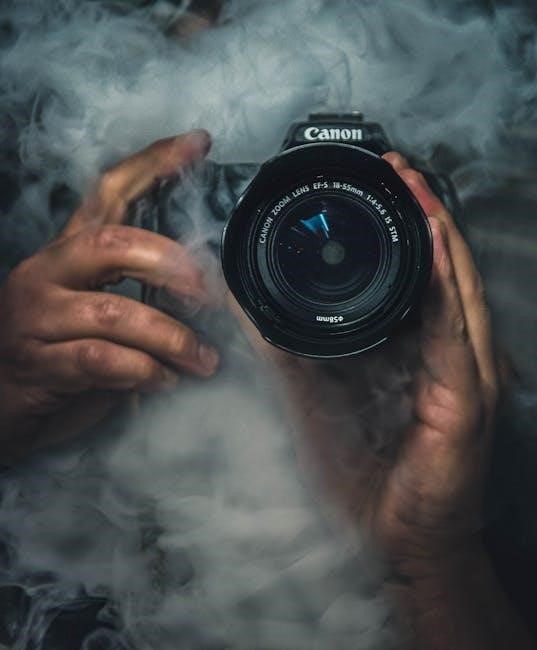
Maintenance and Care
Regular maintenance ensures your Canon EOS 350D performs optimally. Clean the sensor and lens with approved tools. Store in a cool, dry place.
8.1 Cleaning the Sensor and Lens
Cleaning the Canon EOS 350D’s sensor and lens is crucial for maintaining image quality. Use a rubber blower to remove dust from the sensor. For the lens, gently wipe with a microfiber cloth and lens cleaning solution. Avoid touching the sensor with bare hands or unapproved tools. If dust persists, enable the camera’s self-cleaning mode or consult a professional. Regular cleaning prevents scratches and ensures sharp images. Always store the camera in a protective bag to minimize dust exposure. Clean the lens after each use to avoid smudges and fingerprints. Proper care extends the lifespan of your equipment.
8.2 Updating Firmware
Updating the Canon EOS 350D’s firmware enhances performance, adds features, and fixes bugs. Visit Canon’s official website to download the latest firmware version. Use a memory card to transfer the update to the camera. Ensure the battery is fully charged before starting. Copy the firmware file to the memory card’s root directory. Insert the card into the camera, go to the menu, and select “Firmware Update.” Follow on-screen instructions to complete the process. Do not interrupt the update, as it may damage the camera. After completion, restart the camera to apply changes. Refer to Canon’s support page for detailed instructions.
Troubleshooting Common Issues
Troubleshoot common issues like underexposure, autofocus errors, or memory card problems. Identify symptoms, check settings, and consult the manual for solutions. Refer to specific subheadings for detailed fixes.
9.1 Resolving Underexposure Problems
Underexposure occurs when images appear too dark, often due to low lighting or incorrect exposure settings. To fix this, adjust the aperture to a lower f-stop value or increase the shutter speed. Use exposure compensation by pressing the AV +/- button and adjusting the scale. Ensure the ISO is set appropriately for the lighting conditions. Check the metering mode (Evaluative, Center-Weighted, or Spot) to ensure it’s suited to your scene. Review images on the LCD and use the histogram to assess exposure. If issues persist, refer to the manual for advanced solutions or update your firmware for improved performance.
9.2 Fixing Autofocus Errors
If your Canon EOS 350D is experiencing autofocus errors, start by ensuring the lens is properly attached and clean. Check the autofocus mode (One-Shot, AI Servo, or AI Focus) to match your subject. Use the AF Mode Button to switch modes. Ensure the AF point is accurately aligned with your subject. Clean the lens and camera sensor to avoid interference; If issues persist, reset the camera to default settings or update the firmware. For severe problems, perform a manual focus or consult a professional. Regular maintenance and proper handling can prevent recurring autofocus errors and ensure optimal performance.
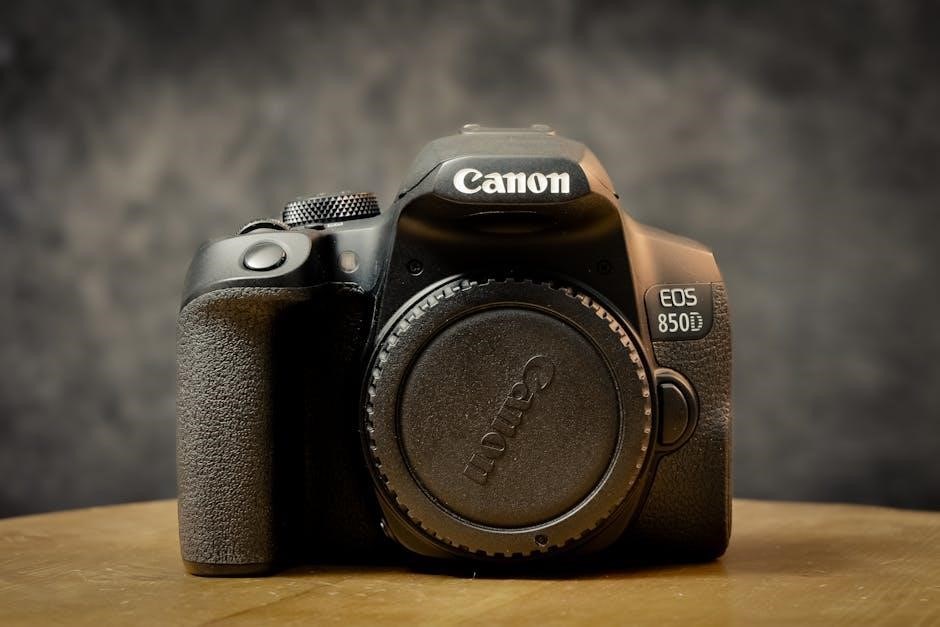
Firmware Updates
Regular firmware updates enhance performance, add features, and fix bugs. Check the current version, visit Canon’s website, and follow on-screen instructions to download and install updates. Ensure the camera is off during installation to avoid interruptions.
10.1 Downloading and Installing Firmware
Visit Canon’s official website and navigate to the support section. Select the EOS 350D model and download the latest firmware version. Ensure the camera battery is fully charged. Connect the camera to your computer using a USB cable. Extract the firmware file and copy it to the memory card’s root directory. Insert the card into the camera, go to the menu, and select the firmware update option. Follow on-screen instructions to complete the installation. Avoid interrupting the process to prevent corruption. Once updated, restart the camera to apply the new firmware. Always verify the firmware version post-update for confirmation.
10.2 Benefits of Updating Firmware
Updating the Canon EOS 350D’s firmware enhances performance, fixes bugs, and adds new features. It improves compatibility with lenses and accessories, ensuring optimal functionality. New firmware versions often include enhancements for autofocus, metering, and image processing. Updating also boosts camera stability, reducing errors during operation. Additionally, firmware updates may introduce new shooting modes or customization options. Security patches are occasionally included to protect against vulnerabilities. Regular updates ensure the camera operates at its best, delivering improved image quality and reliability. Keeping the firmware up-to-date is essential for professional and enthusiast photographers seeking consistent results. Always update using Canon’s official instructions to avoid potential issues.

Accessories and Compatible Lenses
Explore essential accessories like tripods, external flashes, and remote shutters to enhance your photography experience. The Canon EOS 350D supports EF-S and EF lenses, offering versatile focal lengths for diverse shooting needs.
11.1 Recommended Lenses for the Canon EOS 350D
The Canon EOS 350D is compatible with EF-S and EF lenses, offering a wide range of options for photographers. For everyday shooting, the EF-S 18-55mm f/3.5-5.6 kit lens is a versatile choice. The EF 50mm f/1.8 II is ideal for portraits, delivering sharp images with a shallow depth of field. For telephoto needs, the EF 70-300mm f/4-5.6 IS USM is a solid option, featuring image stabilization. Prime lenses like the EF 28mm f/2.8 and EF 85mm f/1.8 USM are excellent for low-light and portrait photography. The EF-S 10-22mm f/3.5-4.5 USM is perfect for wide-angle shots. These lenses enhance creativity and image quality, catering to various photography styles.
11.2 Essential Accessories for Enhanced Shooting
To maximize your shooting experience with the Canon EOS 350D, consider investing in essential accessories. A sturdy tripod, such as the Manfrotto BeFree, ensures stability for long exposures and time-lapse photography. High-capacity memory cards, like SanDisk Extreme Pro, provide ample storage for RAW files. An external flash unit, such as the Canon Speedlite 580EX, enhances lighting control. A remote shutter release or wireless remote prevents camera shake during shots. Protective gear, including a padded camera bag and UV filters, safeguards your equipment. Additional batteries and a battery grip are useful for extended shoots. These accessories elevate your photography workflow and creativity.
The Canon EOS 350D is a versatile and reliable DSLR, offering excellent performance for both beginners and advanced photographers. Its durability, intuitive controls, and robust feature set make it a solid choice for capturing high-quality images. With proper care and accessories, it continues to deliver outstanding results, making it a recommended option for enthusiasts and professionals alike.
12.1 Summary of Key Features
The Canon EOS 350D is an 8.0-megapixel DSLR featuring an APS-C CMOS sensor and DIGIC II image processor for enhanced image quality. It offers a 2.4-inch LCD screen for image review and supports RAW and JPEG formats. The camera includes a 9-point autofocus system, ISO range of 100-1600, and continuous shooting at up to 3 fps. It uses SD/SDHC cards and is compatible with EF-S lenses. Battery life is robust, and its durable design ensures reliability. The EOS 350D is user-friendly, making it ideal for both beginners and experienced photographers seeking a balance of performance and portability.
12.2 User Satisfaction and Recommendations
The Canon EOS 350D has garnered positive feedback for its ease of use and versatility, making it a favorite among hobbyists and professionals alike. Users appreciate its lightweight design, responsive controls, and excellent image quality. The camera’s intuitive interface and customizable settings cater to both beginners and advanced shooters. However, some users note the lack of live view and a smaller LCD as minor drawbacks. Overall, the EOS 350D is highly recommended for those seeking a reliable DSLR for photography. It remains a solid choice for enthusiasts and collectors of vintage camera gear, offering great value for its performance and durability.